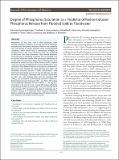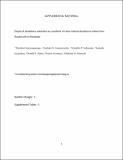| dc.contributor.author | Kumaragamage, Darshani | |
| dc.contributor.author | Amarawansha, Geethani S. | |
| dc.contributor.author | Indraratne, Srimathie P. | |
| dc.contributor.author | Jayarathne, Kumudu | |
| dc.contributor.author | Flaten, Donald N. | |
| dc.contributor.author | Zvomuya, Francis | |
| dc.contributor.author | Akinremi, Olalekan O. | |
| dc.date.accessioned | 2020-11-09T21:28:44Z | |
| dc.date.available | 2020-11-09T21:28:44Z | |
| dc.date.issued | 2019-11-01 | |
| dc.identifier.citation | Kumaragamage, Darshani, Geethani S. Amarawansha, Srimathie P. Indraratne, Kumudu Jayarathne, Donald N. Flaten, Francis Zvomuya, and Olalekan O. Akinremi. "Degree of Phosphorus Saturation as a Predictor of Redox-Induced Phosphorus Release from Flooded Soils to Floodwater." Journal of Environmental Quality 48(6) (November-December 2019): 1817-1825. DOI: 10.2134/jeq2019.04.0154. | en_US |
| dc.identifier.issn | 1537-2537 | |
| dc.identifier.uri | https://hdl.handle.net/10680/1852 | |
| dc.description.abstract | Phosphorus (P) loss from soils is often enhanced under flooded, anaerobic conditions, increasing the risk of freshwater eutrophication. We aimed to develop a predictive tool to identify soils with greater P release potential under summer‐flooded conditions, which would help in developing strategies to mitigate P losses. One in situ mesocosm study was conducted in field plots with three treatments: cattle manure amended, monoammonium phosphate amended, and unamended. Two ex situ field mesocosm studies were conducted, each having 12 surface soils from agricultural fields. Prior to flooding, soils were analyzed for various soil test P (STP, intensity) and P sorption measures (capacity), and degree of P saturation (DPS) indices were calculated using different intensity and capacity combinations. Mesocosms were flooded and redox potential, pore water, and floodwater dissolved reactive P (DRP) concentrations were determined periodically up to 42 (in situ) and 56 d (ex situ) after the onset of flooding. Floodwater DRP increased significantly in most soils with flooding time, and the maximum DRP (DRPmax) was considered as the flooding‐induced P release risk. Relationships between floodwater DRPmax and STP or DPS indices were established separately for low‐P (Olsen P ≤ 30 mg kg−1) and high‐P (>30 mg kg−1) soils. Several STP indices effectively predicted the P release risk from high‐P soils, but not from low‐P soils. However, DPS calculated using Olsen P (intensity) and P sorption capacity or P saturation index (capacity) performed better in predicting summer flooding‐induced P release across all soil categories, with a higher predictive power. | en_US |
| dc.description.sponsorship | "This work was supported by the Manitoba Conservation and Water Stewardship Fund, Environment Canada through the Lake Winnipeg Basin Stewardship Fund (EC no. 1300328), and a University of Winnipeg major grant. We also acknowledge the Manitoba Graduate Scholarship program and the University of Winnipeg Graduate Assistantship Program." | en_US |
| dc.description.uri | https://acsess.onlinelibrary.wiley.com/doi/10.2134/jeq2019.04.0154 | en_US |
| dc.language.iso | en | en_US |
| dc.publisher | American Society of Agronomy, Crop Science Society of America, and Soil Science Society of America | en_US |
| dc.rights | info:eu-repo/semantics/openAccess | en_US |
| dc.subject | Phosphorus -- Environmental aspects | en_US |
| dc.title | Degree of Phosphorus Saturation as a Predictor of Redox-Induced Phosphorus Release from Flooded Soils to Floodwater | en_US |
| dc.type | Article | en_US |
| dc.rights.license | CC BY‐NC‐ND license | en_US |
| dc.identifier.doi | 10.2134/jeq2019.04.0154 | en_US |


